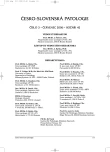Leiomyoma of the Gastrointestinal Tract with Intracytoplasmic Inclusion Bodies Report of Three Cases
Authors:
P. Dundr; C. Povýšil; D. Tvrdík
Authors‘ workplace:
Institute of Pathology, 1st Medical Faculty, Charles University, Prague, Czech Republic
Published in:
Čes.-slov. Patol., 42, 2006, No. 3, p. 139-144
Category:
Overview
We report three cases of leiomyoma of the gastrointestinal tract with intracytoplasmic inclusion bodies similar to those characteristic of inclusion body fibromatosis (IBF). The first two cases represent leiomyoma of the stomach: one in a 70-year-old female and the other in a 72-year-old female. In both instances inclusion bodies were present in a large amount. In the third case the leiomyoma was located in the esophagus of a 63-year-old male and inclusion bodies in this case were rare. In all three cases an immunohistochemical analysis showed positivity of the tumor cells for muscle specific actin HHF35 (MSA), α-smooth muscle actin (SMA), h-caldesmon and desmin. The first case showed some inclusion bodies with positivity for cytokeratin CAM 5.2 and focal weak positivity for cytokeratin 18. In the second case the inclusion bodies were positive at the periphery with antibodies directed against MSA and SMA. In the third case the inclusion bodies were immunohistochemically entirely negative. Ultrastructurally, the inclusion bodies in the first case were composed of aggregated filaments, some with entrapped cytoplasmic organels and others with finely granular dense cores.
Key words:
leiomyoma - inclusion bodies - eosinophilic bodies - infantile digital fibromatosis
Labels
Anatomical pathology Forensic medical examiner ToxicologyArticle was published in
Czecho-Slovak Pathology

2006 Issue 3
Most read in this issue
- Sessile Serrated Adenomas of the Large Bowel. Clinicopathologic and Immunohistochemical Study Including Comparison with Common Hyperplastic Polyps and Adenomas
- Low Grade Myofibroblastic Sarcoma of Tongue: a Case Report
- Leiomyoma of the Gastrointestinal Tract with Intracytoplasmic Inclusion Bodies Report of Three Cases
- The Use of Immunohistochemistry in the Differential Diagnosis of Thyroid Gland Tumors with Follicular Growth Pattern
